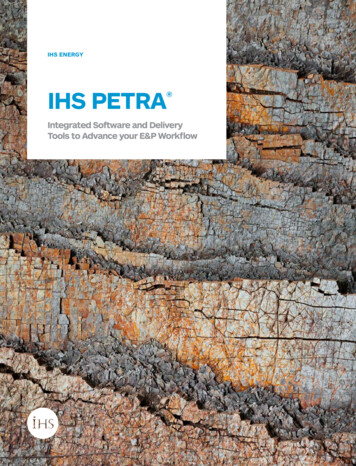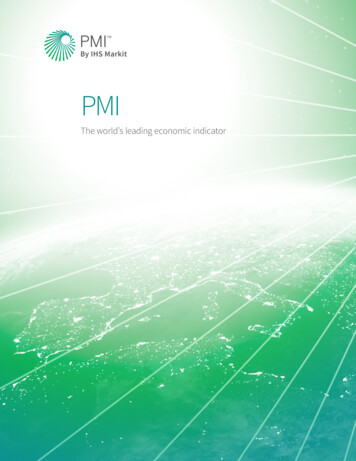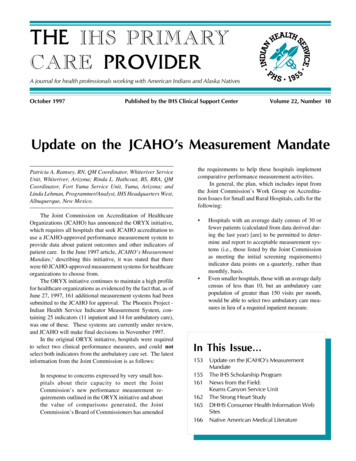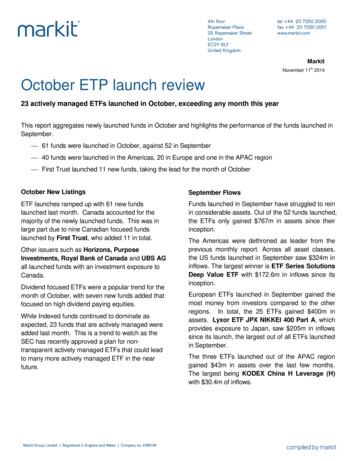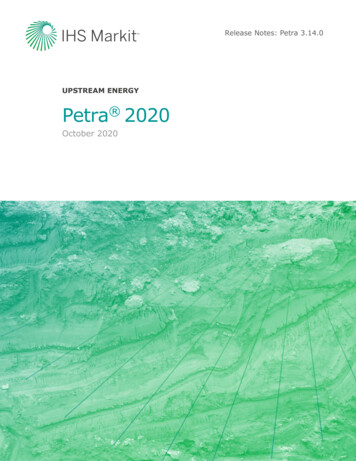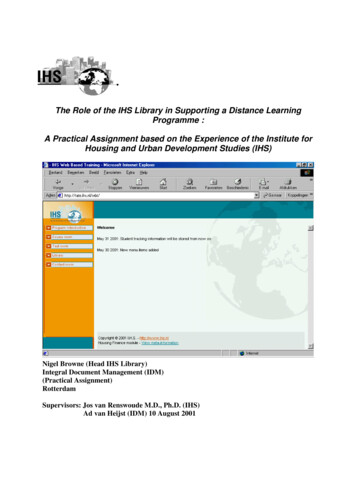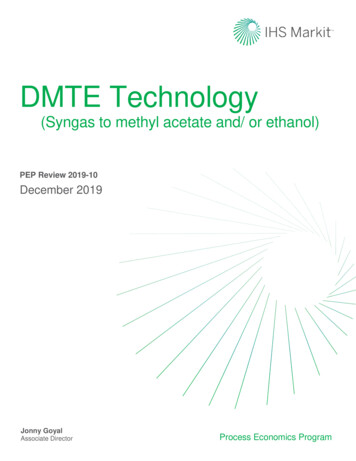
Transcription
DMTE Technology(Syngas to methyl acetate and/ or ethanol)PEP Review 2019-10December 2019Author NameIHS Job TitleAuthor NameIHS Job TitleAuthor NameIHS Job TitleJonny GoyalAssociate DirectorProcess Economics Program
IHS Markit PEP Review 2019-10 DMTE Technology: Syngas to methyl acetate and/or ethanolPEP Review 2019-10DMTE Technology: Syngas to methyl acetate and/ orethanolJonny Goyal, Associate DirectorAbstractYanchang Zhongke (Dalian) Energy Technology Co., Ltd. was established in January 2017 in the cityDalian, Liaoning, China. The key stakeholders of the company are Shaanxi Yanchang Petroleum (Group)Corp. Ltd. and Dalian Institute of Chemical Physics, Chinese Academy of Sciences (DICP). To answerthe need of China’s ethanol fuel program, the company is licensing newly developed route to produceethanol from syngas. This technology is their DMTE technology. DMTE stands ne.The company successfully commissioned 100,000 metric tons per year capacity anhydrous ethanol plantfrom coal in China in January 2017. The company has aggressive plan to sell this technology in marketwith different portfolio of chemicals under their technology basket. This PEP review evaluates twoaspects of DMTE technology taking syngas as a feedstock:1. Production economics for methyl acetate2. Production economics for ethanolThe economics of producing methyl acetate directly from syngas shows highly favorable results due tohigher methyl acetate price in market as compared to ethanol. We see some challenges for ethanolproduction economics mainly because of high-fixed and operating cost involved in distilling azeotropiccomponents. This makes the conventional routes of producing anhydrous ethanol dominant in theprevailing ethanol market price. But there is a window where the production economics can be reducedby adjusting the proportions of methyl acetate, ethanol, and methanol according to the market demand toimprove the flexibility of products. This has important realistic sense for developing new coal chemicalindustry.Confidential. 2019 IHS Markit. All rights reserved.1December 2019
IHS Markit PEP Review 2019-10 DMTE Technology: Syngas to methyl acetate and/or ethanolContents1IntroductionConventional route syngas to ethanolDMTE syngas to ethanol routeIndustrial demonstrationTechnology prospectsScope of this review2SummaryEconomic aspectsCapital cost economics comparisonProduct cost economics comparisonCarbon and water footprints3Industry statusEthanol trade in ChinaCoal to ethanol project status in ChinaMethyl acetate market4Technical reviewProcess technical review/ chemistryCryogenic separation: Partial condensation process (Technical Review/Chemistry)DME synthesis from methanolDME carbonylation to produce methyl acetateMethyl acetate hydrogenationProduct ethanol separationProcess catalyst reviewIHS Markit communication with DMTE Licensor5DMTE: Syngas to methyl acetateIntroductionCase assumptions and process design basisProcess descriptionSection 100—Syngas separationSection 200—DME synthesisSection 300—DME carbonylationProcess discussionSection 100—Syngas separationSection 200—DME synthesisSection 300—DME carbonylationCost estimatesFixed capital costsProduction costsSensitivity analysis (Variation of feedstock price, plant operating level etc.)6DMTE: Syngas to ethanolIntroductionCase assumptions and process design basisProcess descriptionSection 400—Methyl acetate hydrogenationProcess discussionSection 400—Methyl acetate hydrogenationDiscussion on Product separation (inverted-sequence distillation)Cost estimatesFixed capital costsProduction costsSensitivity analysis (Variation of feedstock price, plant operating level etc.)Appendix A—Patent summaries by assigneeAppendix B—Cited referencesAppendix C—Process flow diagramsConfidential. 2019 IHS Markit. All rights 72727476808693August 2019
IHS Markit PEP Review 2019-10 DMTE Technology: Syngas to methyl acetate and/or ethanolTablesTable 2.1 Overall comparison of capital investment and production cost13Table 2.2 Carbon dioxide emissions and water consumption by process15Table 3.1 Chinese consumption of ethanol17Table 3.2 Chinese trade in ethanol17Table 3.3 Coal-to-ethanol projects list in China18Table 4.1 The composition of methyl acetate-methanol azeotrope system under differentpressures28Table 4.2 Heterogeneous catalyst for methanol/DME carbonylation30Table 4.3 DME Carbonylation over Zeolite catalysts31Table 4.4 DME Carbonylation over Transition-Metal-Modified HMORs32Table 5.1 DMTE process: Syngas to methyl acetate—Basis of design37Table 5.2 Comparison of different reactor systems used for DME synthesis42Table 5.3 DMTE technology: Syngas to methyl acetate—Material stream flows45Table 5.4 DMTE technology: syngas to methyl acetate—Major equipment49Table 5.5 DMTE technology: Syngas to methyl acetate—Utility summary50Table 5.6 DMTE technology: Syngas to methyl acetate—Total capital investment52Table 5.7 DMTE technology: syngas to methyl acetate—Production cost54Table 6.1 DMTE process: Syngas to methyl acetate—Basis of design60Table 6.2 The results of simulation and optimization in the inverted sequence-distillationprocess scheme66Table 6.3 DMTE technology: Syngas to ethanol—Material stream flows66Table 6.4 DMTE technology: syngas to ethanol—Major equipment69Table 6.5 DMTE technology: Syngas to ethanol—Utility summary72Table 6.6 DMTE technology: Syngas to ethanol—Total capital investment73Table 6.7 DMTE technology: Syngas to ethanol—Production cost75FiguresFigure 1.1 Conventional route syngas to ethanolFigure 1.2 DMTE syngas to ethanol routeFigure 1.3 DMTE: Industrial demonstrationFigure 1.4 DMTE: Technology prospectsFigure 2.1 Capital cost economics comparisonFigure 2.2 Production cost comparisonFigure 3.1 China ethanol supply gapFigure 4.1 Syngas to ethanol configurationsFigure 4.2 Reaction routes for syngas conversion to ethanolFigure 4.3 Simplified flow diagram for the partial condensation process for obtaining CO &8910101414162223H224Figure 4.4 Simplified flow diagram of DME synthesis from methanol25Figure 4.5 Simplified flow diagram of DME carbonylation26Figure 4.6 Simplified flow diagram of methyl acetate hydrogenation and product separation 27Figure 4.7 Methanol to DME reaction catalysts and respective conversions29Figure 4.8 Proposed mechanism for DME carbonylation over zeolites33Figure 4.9 DMTE process route (provided by licensor)34Figure 5.1 DMTE technology: Syngas to methyl acetate—Effect of plant capacity oninvestment cost53Figure 5.2 DMTE technology: Syngas to methyl acetate—Effect of syngas price on netproduction cost and product value56Figure 5.3 DMTE technology: Syngas to methyl acetate—Effect of methanol price on netproduction cost and product value56Figure 5.4 DMTE technology: Syngas to methyl acetate—Product value of methyl acetate as afunction of operating level and plant capacity57Confidential. 2019 IHS Markit. All rights reserved.3December 2019
IHS Markit PEP Review 2019-10 DMTE Technology: Syngas to methyl acetate and/or ethanolFigure 5.5 DMTE technology: Syngas to methyl acetate—Net production cost of methyl acetateas a function of operating level and plant capacity57Figure 6.1 The Reflux Ratio (R) vs Theoretical Stages (Nt) of the Ethanol Separation Columnin the Inverted Sequence Distillation Process64Figure 6.2 Effects of Reflux Ratio (R) on Ethanol Mass Fraction (w) and Reboiler Duty (Q) ofthe Ethanol Separation Column in the Invented Sequence Distillation Process65Figure 6.3 DMTE technology: Syngas to ethanol—Effect of plant capacity oninvestment cost74Figure 6.4 DMTE technology: Syngas to ethanol—Effect of syngas price on net production costand product value77Figure 6.5 DMTE technology: Syngas to ethanol—Effect of methanol price on net productioncost and product value77Figure 6.6 DMTE technology: Syngas to ethanol—Product value of ethanol as a function ofoperating level and plant capacity78Figure 6.7 DMTE technology: Syngas to ethanol—Net production cost of ethanol as a functionof operating level and plant capacity78Appendix C FiguresFigure 7.1 DMTE Technology Section I (Syngas Separation)Figure 7.2 DMTE Technology Section II (One-step DME synthesis)Figure 7.3 DMTE Technology Section III (DME Carbonylation)Figure 7.4 DMTE Technology (Methyl Acetate Hydrogenation)Confidential. 2019 IHS Markit. All rights reserved.494959697December 2019
IHS Markit Customer Care:CustomerCare@ihsmarkit.comAmericas: 1 800 IHS CARE ( 1 800 447 2273)Europe, Middle East, and Africa: 44 (0) 1344 328 300Asia and the Pacific Rim: 604 291 3600DisclaimerThe information contained in this presentation is confidential. Any unauthorized use, disclosure, reproduction, or dissemination, in full or in part, in any mediaor by any means, without the prior written permission of IHS Markit Ltd. or any of its affiliates ("IHS Markit") is strictly prohibited. IHS Markit owns all IHSMarkit logos and trade names contained in this presentation that are subject to license. Opinions, statements, estimates, and projections in this presentation(including other media) are solely those of the individual author(s) at the time of writing and do not necessarily reflect the opinions of IHS Markit. Neither IHSMarkit nor the author(s) has any obligation to update this presentation in the event that any content, opinion, statement, estimate, or projection (collectively,"information") changes or subsequently becomes inaccurate. IHS Markit makes no warranty, expressed or implied, as to the accuracy, completeness, ortimeliness of any information in this presentation, and shall not in any way be liable to any recipient for any inaccuracies or omissions. Without limiting theforegoing, IHS Markit shall have no liability whatsoever to any recipient, whether in contract, in tort (including negligence), under warranty, under statute orotherwise, in respect of any loss or damage suffered by any recipient as a result of or in connection with any information provided, or any course of actiondetermined, by it or any third party, whether or not based on any information provided. The inclusion of a link to an external website by IHS Markit should notbe understood to be an endorsement of that website or the site's owners (or their products/services). IHS Markit is not responsible for either the content oroutput of external websites. Copyright 2018, IHS MarkitTM. All rights reserved and all intellectual property rights are retained by IHS Markit.
higher methyl acetate price in market as compared to ethanol. We see some challenges for ethanol . Table 2.2 Carbon dioxide emissions and water consumption by process 15 Table 3.1 Chinese consumption of ethanol 17 . Figure 6.2 Effects of Reflux Ratio (R) on Ethanol Mass Fraction (w) and Reboiler Duty (Q) of

